La Caseta de Milmanda is a
Catalan community-based eco-project located on some farmland in a
beautiful, rural valley outside L'Espluga de Francolí. It provides
organic, seasonal produce to local families and businesses, and also
holds classes and workshops on sustainable agriculture and natural
building techniques.
During 2011 and 2012, I
had the pleasure of living and working at La Caseta de Milmanda,
managing construction and maintenance works for their organization.
And, with the help of the organizers at l'Associació Persei, in February 2012 I taught a workshop at Milmanda on How to Design and Build a Thermal Mass Stove.
During this weekend
workshop, we transformed a large, old fireplace in the Milmanda
farmhouse into a vastly more efficient thermal mass stove, without
altering the existing structure of the fireplace and chimney. To
accomplish this, we first built and installed a lightweight
stove pipe system inside the old chimney. Then we built a new firebox
with a white oven on top, in the old fireplace. This was connected to
the stovepipe system and a variety of clay mixes were applied to
absorb the heat from the exhaust gases and radiate into the house
(rather than send all the heat straight up the chimney, like the old
fireplace did).
The workshop was kept
small, with 5 participants, because the work site was indoors and
cramped. We began with the classroom element of the workshop,
introducing the basic principles of the thermal mass stove and the
transference of heat. We reviewed the development of these stoves
through history, and introduced some well-known models, like the
Russian Stove, the German Kachelofen, and the modern masonry heater.
Then we got into the
specifics of designing a thermal mass stove. We learned how to
properly scale the stove in relation to the space it is being built
to heat. We learned how to calculate the size of the space, the
insulation value of the walls, and the rate of heat loss during
design conditions. The stove must meet the necessary heat rating to
ensure it can maintain a comfortable temperature inside, even during
the coldest months of the year.
After the classroom
element of the workshop, we got down to business. The firebox, white
oven and internal heat riser of the stove were built using firebricks
and refractory mortar. We avoided using large lintels in the design
by instead building a series of arches using a simple wooden form.
We built a stovepipe
system that could be installed inside the old chimney, without
modifying the existing structure. To do this, we built 2 support
columns off to the sides in the old fireplace, using salvaged bricks
and a cob mortar. These support columns would help to bear the weight
of the new stove components. We then surrounded the entire stove and
stovepipe system with various clay-based mixes. We made an insulative
mix using expanded clay to slow down the rate of heat loss in the
firebox, white oven and heat riser, and a denser mix was used to
direct the conduction of heat towards the face of the stove and into
the room.
Following the workshop, a
group of volunteers and I put the finishing touches on the stove. We
installed a stone facade over the stove, to help it blend in with the
original stonework of the fireplace and chimney. After this, we
installed new metal doors for the firebox and white oven, built for
us by a local metalworker.
Below you can see the
photos of the finished thermal mass stove. The photos also show that
in preparation for the workshop, I had replaced the old wooden mantel
shelf (the old one had some fire damage). I had also installed a bit
of ductwork in the chimney to take cold air from the downstairs
pantry, heat it with the new thermal mass stove, and send it upstairs
to heat the bedrooms. I did this outside of the workshop because they
were optional extras, and they also required modifying the existing
structure – something I had promised during the workshop that we
wouldn't be doing.
I would like to send a
hearty thank you to everyone that made this workshop possible. My
time working with l'Associació Persei and La Caseta de Milmanda was a true pleasure, and we met
a really great group of students and volunteers along the way. I hope
Milmanda's new thermal mass stove will be cooking Maria's delicious
Catalan casseroles for many years to come!
- Ben
























Ben, beautiful work! This is a great blog and I'm so excited to see the evolution of your projects...can't wait to see the rest!
ReplyDeleteWe're a group of volunteers and opening a new scheme in our community. Your web site offered us with helpful information to work on. You have done a formidable activity and our whole community will be grateful to you.
ReplyDeleteHey~ Ben. I feel really happy. Very beautiful works and so many creative things is impressive.(And I just find my photo.:)-) I really hope you doing more and more nice works on everywhere on earth( or even more than earth). Someday I want to work with you. Please co-work with me !!!:) Nice~ man!!!
ReplyDelete